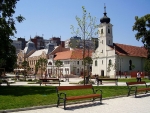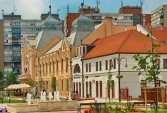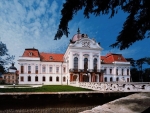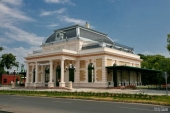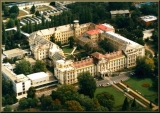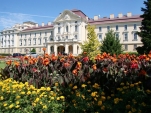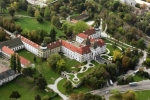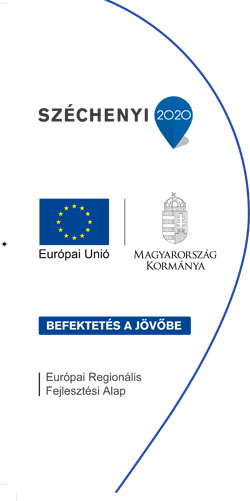Travel to Gödöllő from Budapest takes only 30 minutes by car and 45 minutes by the suburban train. Liszt Ferenc Airport is only a 20-25 minutes drive from Gödöllő, shorter than from Budapest....
Gödöllő is a town for lovers of art, history and literature so it is no surprise that everybody will find his/her interest:
.... lovers of art and literature will find unique art experiences,
.... those interested in Queen Elizabeth's legendary life or the history of Hungarian scouting will also be offered possibilities to explore history
.....Pilgrims are welcome at Virgin Mary shrine to discover a special spiritual experience
Highlights of the town
Royal Palace – Gödöllői Királyi Kastély
The Gödöllö Royal Palace is the largest Baroque style palace in Hungary. It was built in 1735 by Count Antal Grassalkovich I, one of the most notable aristocrats of the 18th century. The double U-shaped, 8 –winged building was flanked by a church, orangery and bath house to the north and stables and a riding hall to the south
The second golden age of the builing began in 1867. Bought and reconstructed by the Hungarian State, the Palace was presented as coronation gift to Emperor Francis Joseph I and Queen Elisabeth, for use as a residence. The royal family would spend the spring and autumn hunting seasons here. They often celebrated the Christmas in the Gödöllő Palace. Queen Elisabeth spent about 2000 nights in the Palace
From 1920 onwards the Palace served as a summer retreat for Governor Miklós Horthy. This period ended with the outbreak of World War II. Although the building itself was left undamaged, most of the furnishings were carried away or destroyed by the German and Russian troops invading in 1944.
From 1945 onwards Soviet troops were stationed in the outbuildings, while the main building, classified as a historic monument, became a home for the elderly. These abuses led to a gradual decay of the Palace over the following decades.
Thanks to conservation work on the Palace, the first permanent exhibition was opened in 1996: the ceremonial hall and the royal suites. Several new halls have been added to the exhibition since then. Renovation of the Baroque Theatre was completed in 2003 and the Royal Pavilion in 2004.
2010 saw the Gisela and Rudolph wings (named after the royal children) restored to their former splendour with EU support, a section of the Park was renovated and reconstruction of the Riding Hall and the Baroque Stables were completed.
Historical traditions, a variety of cultural events and its wonderfully restored, uniquely impressive complex and surroundings make the Palace one of the most attractive and exciting buildings and institutions in Hungary.
Royal Waiting Hall
The royal waiting hall was built in 1874, based on the plans of Miklós Ybl in eclectic style, ornamented with Ionic columns. To the right of the large waiting hall opened the waiting room of Queen Elisabeth, and to the left, that of Francis Joseph. In the queen's room the silk wall-paper and the furniture coverings were light yellow, while the room of the king was green.
Saint Stephen University – Szent István Egyetem
The city is home to the Saint Stephen University, a renowned institution of agriculture.
The main building of the University was originally built for the Premonstrant order in 1924 and it was used for educational purposes
Workshop of Applied Arts – Gödöllői Iparművészeti Műhely
Gödöllő also played a significant role in Hungarian art history. Between 1901 and 1920, the artists' colony of Hungarian Art Nouveau was based here.
The to-day workshop was founded in 1998 to rally professional artists of national and international renown, living in and around Gödöllő. The aim of the workshop is to perpetuate and disseminate the spirit and artistic traditions of the Art Deco Colony from the early 20th century
The GIM House ( Workshop of Applied Arts ) hosts contemporary art exibitions and the studios of the artists can be visited
Máriabesnyő – Basilica Minor - Pilgrimage site
The two storey baroque church with the two altars and the Virgin Mary Statues is a unique site in Hungary that attracts thousands of pilgrims every year
In the documents of the 18th century Máriabesnyő can be found as an uninhabited desert belonging to Gödöllő. In 1737 Antal Grassalkovich I. purchased the neighbouring estates.
The third wife of Antal Grassalkovich I., Terézia Klobusiczky planned the building of a Loreto chapel in Besnyő, in the place of the ruins of the former premontran church, overgrown by forest. In the course of digging, one of the masons, guided by a dream – found in the earth a statuette carved of bone on April 19, 1759. The ivory carving of the XII –XIII century represents the Virgin Mary with the child Jesus in her arms. Following this, Grassalkovich I had the statuette decorated with 23 cut diamonds and put it into a jewel-case of silver and crystal glass and kept it in the palace chapel.
The statue of the Holy Virgin found under miraculous circumstances attracted thousands of pilgrims to this place. The main pilgrimages in Máriabesnyő are on August 15 and September 8.
The convent of the Salvador Sisters is next to the Capuchin Monastery. The former Hungarian Prime Minister, Count Pál Teleki's remains lie in the cemetery.
Máriabesnyő is now a part of the town of Gödöllő.
